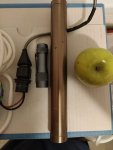Benjamax
Well-known member
- Joined
- Aug 16, 2020
- Messages
- 19
- Points
- 63
A distant relative gave me this old HeNe Laser many years ago that was being used in the 1990s.
The laser has no sticker or other markings on it except "Spectra Physics HeNe Laser" on the front.
Also came with the original Spectra Physics transformer. Sticker on it says Model 229-7P.
I searched the model and found the transformer being sold here and there but nothing about the laser.
Mine has a hole on the sticker where the first digit for the current is, but from online images it says 60mA / 120V. So it feeds 7.2W to the laser - What does that mean for the actual optical output? I have no LPM or a scanning wavemeter.
Would be happy to know what this laser was used for too
Edit: kept searching, actually found something right after posting this. On ebay 2 similar looking lasers. One says model 196-2 and the other 105-1
"Spectra-Physics-196-2-Laser-"
"Spectra-Physics-HeNe-laser-TESTED-GOOD-Siemens-Uniphase-JDS-solid-state-diode-"
Also found specifications for the 105 here
/brochures/SP105L1984/sp1052.html
could not post links due to low number of posts in the forum.
So seems like they made more than one laser with an identical looking tube, so without the sticker I guess there's no way to identify. still wonder what it was used for.
The laser has no sticker or other markings on it except "Spectra Physics HeNe Laser" on the front.
Also came with the original Spectra Physics transformer. Sticker on it says Model 229-7P.
I searched the model and found the transformer being sold here and there but nothing about the laser.
Mine has a hole on the sticker where the first digit for the current is, but from online images it says 60mA / 120V. So it feeds 7.2W to the laser - What does that mean for the actual optical output? I have no LPM or a scanning wavemeter.
Would be happy to know what this laser was used for too
Edit: kept searching, actually found something right after posting this. On ebay 2 similar looking lasers. One says model 196-2 and the other 105-1
"Spectra-Physics-196-2-Laser-"
"Spectra-Physics-HeNe-laser-TESTED-GOOD-Siemens-Uniphase-JDS-solid-state-diode-"
Also found specifications for the 105 here
/brochures/SP105L1984/sp1052.html
could not post links due to low number of posts in the forum.
So seems like they made more than one laser with an identical looking tube, so without the sticker I guess there's no way to identify. still wonder what it was used for.
Attachments
Last edited:






